What Is the Difference Between English and French Angora Rabbits?

Differences Between English and French Angora Rabbits:
- Size: English Angoras are generally larger than French Angoras, with different body shapes and proportions.
- Fur Texture: English Angoras have a silky, long coat, while French Angoras have a dense, wool-like fur.
- Grooming Needs: English Angoras require daily grooming to prevent matting, while French Angoras may need less frequent grooming due to their fur texture.
Physical Characteristics
The English Angora rabbit's distinctive heavy wool on the face and ears sets it apart from the French Angora, which exhibits shorter hair in these areas. This difference in fiber distribution is a key feature when distinguishing between the two Angora rabbit breeds.
The English Angora's wool is consistent throughout its body, providing a more uniform appearance compared to the French Angora. In terms of size, female French Angoras can reach weights of up to 10 1/2 pounds, while female English Angoras typically weigh around 7 1/2 pounds.
Additionally, females in both breeds tend to be larger than males, with French Angoras generally being bigger overall when compared to English Angoras. Understanding these physical characteristics aids in identifying and appreciating the unique attributes of each Angora breed, highlighting the variations in fiber distribution and body size that contribute to their individual charm and appeal.
Wool Quality and Quantity
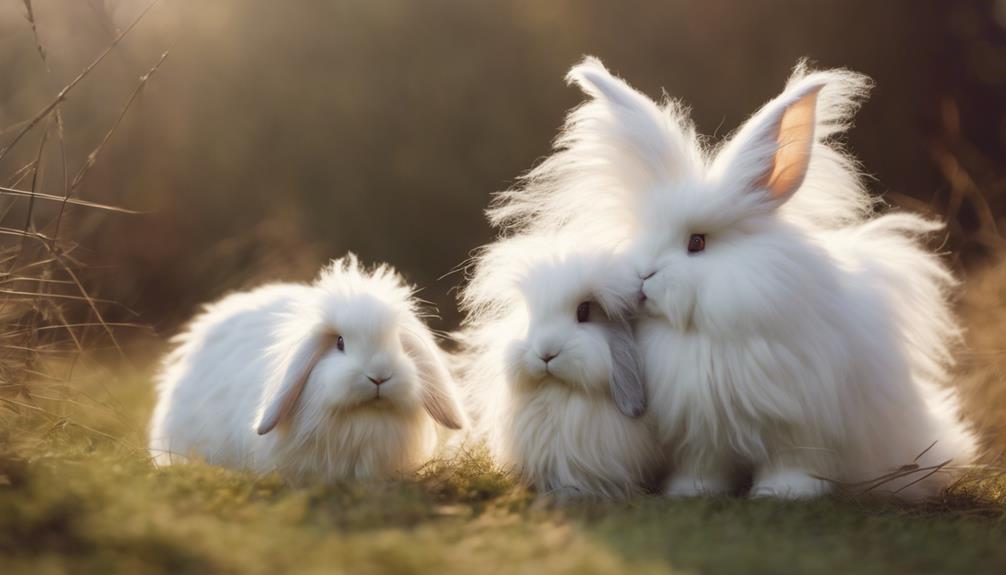
Distinct in their respective wool qualities and quantities, English and French Angora rabbits showcase notable differences that contribute to their unique appeal and suitability for various applications.
English Angora wool stands out for its soft and silky texture, attributed to its minimal presence of guard hairs. This feature makes English Angora wool highly sought after for its luxurious feel, making it ideal for high-end garments and textiles.
On the other hand, French Angora wool contains more guard hairs, giving it a slightly coarser feel compared to its English counterpart. Despite this, French Angoras produce a larger quantity of wool due to their thicker undercoat, making them a preferred choice for projects requiring more yarn.
While English Angora is favored for its premium quality, French Angora is renowned for its dramatic appearance, offering a different aesthetic appeal in wool products. These distinctions in wool quality and quantity make both breeds valuable in the fiber industry, catering to different preferences and needs.
Temperament and Behavior
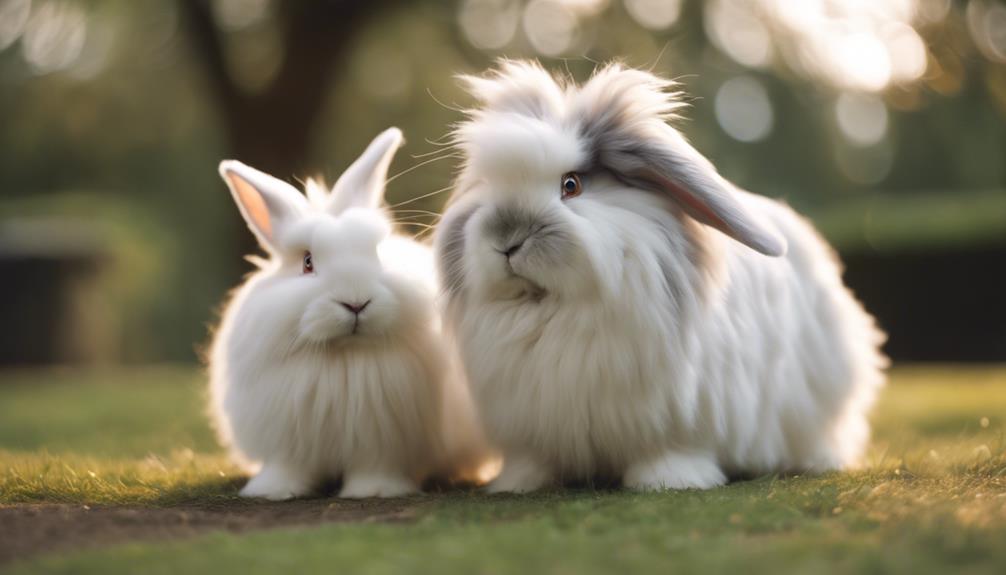
English Angora rabbits are known for being sociable and affectionate, often seeking human interaction.
In contrast, French Angoras tend to be more independent and may not crave as much attention.
Understanding these differences in temperament can help owners tailor their approach to handling and socializing each breed accordingly.
English Rabbits Sociable
Known for their sociable nature, English Angora rabbits exhibit a friendly and interactive demeanor, making them ideal companions for families seeking a docile pet. These rabbits enjoy human interaction and are often docile, which contributes to their suitability as family pets. Their gentle temperament sets them apart from other breeds, making them more tolerant of handling.
English Angoras' sociable behavior allows them to bond well with their owners, forming strong relationships. Their friendly demeanor and social nature enhance their popularity among rabbit enthusiasts as they create a warm and interactive environment within the household.
- Enjoy human interaction
- Docile and tolerant of handling
- Form strong relationships with owners
French Rabbits More Independent
French Angora rabbits exhibit a more independent temperament compared to their English counterparts, displaying a tendency towards self-reliance and less interactive behavior with human owners. While both breeds can be affectionate, French Angoras lean towards being more reserved. This self-sufficiency can be observed in their daily interactions, where they may require less attention and handling from their owners. The table below outlines some key behavioral differences between French Angora and English Angora rabbits:
| Behavior | French Angora | English Angora |
|---|---|---|
| Affection Level | Less affectionate | More affectionate |
| Interaction | More self-reliant | Seeks human attention |
| Temperament | Reserved | Sociable |
| Independence | High | Moderate |
| Human Bonding | Less interactive | More interactive |
Handling and Socialization Differences
In considering the temperament and behavior of Angora rabbits, it's essential to note the significant differences in handling and socialization approaches required for these two breeds.
- English Angoras may be more sensitive and delicate in handling compared to the sturdier French Angoras.
- French Angoras are known for their playful and curious nature, while English Angoras are generally more reserved.
- Socialization is key for both breeds, but English Angoras may require more gentle and patient interactions. French Angoras, on the other hand, tend to be more outgoing and adventurous in their behavior.
These distinctions in socialization and handling methods play a crucial role in nurturing the unique personalities of English and French Angora rabbits.
Grooming Needs
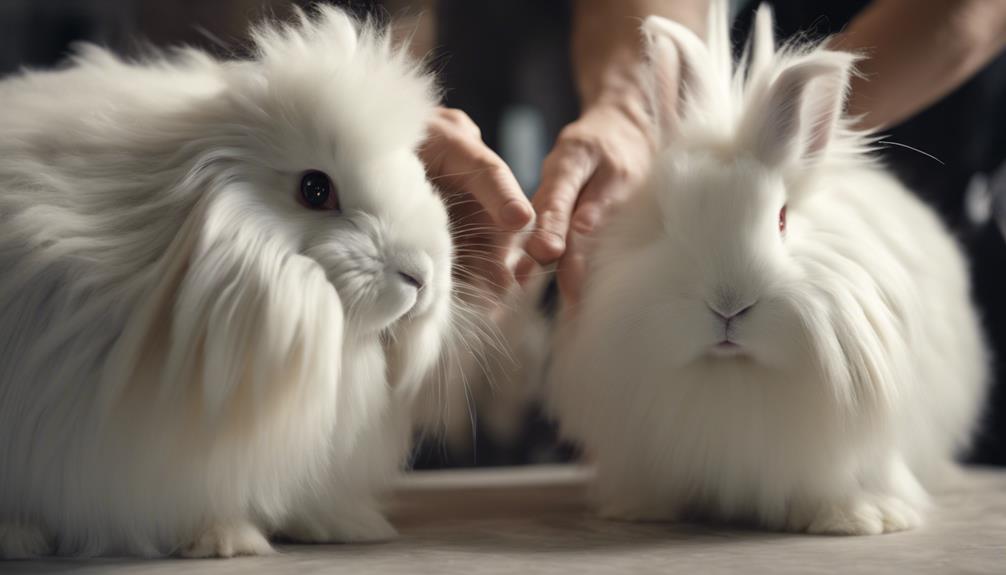
English Angora rabbits are known for their thick, long fur and facial furnishings, requiring meticulous grooming to prevent matting and maintain their soft, silky coat. The grooming needs of English Angoras are more demanding compared to French Angoras.
English Angoras need frequent grooming sessions to prevent their fur from tangling and matting, which can be time-consuming due to the nature of their coat. In contrast, French Angoras have easier grooming requirements with cleaner faces, ears, and front legs. French Angoras feature a smoother coat texture, making grooming less labor-intensive than their English counterparts.
While grooming English Angoras focuses on maintaining the softness and silkiness of their fur, grooming French Angoras is more about keeping their coat clean and tidy. Therefore, individuals looking to adopt an Angora rabbit should consider the grooming commitment required for each breed, with English Angoras needing more attention to prevent matting compared to French Angoras.
Size and Weight Differences
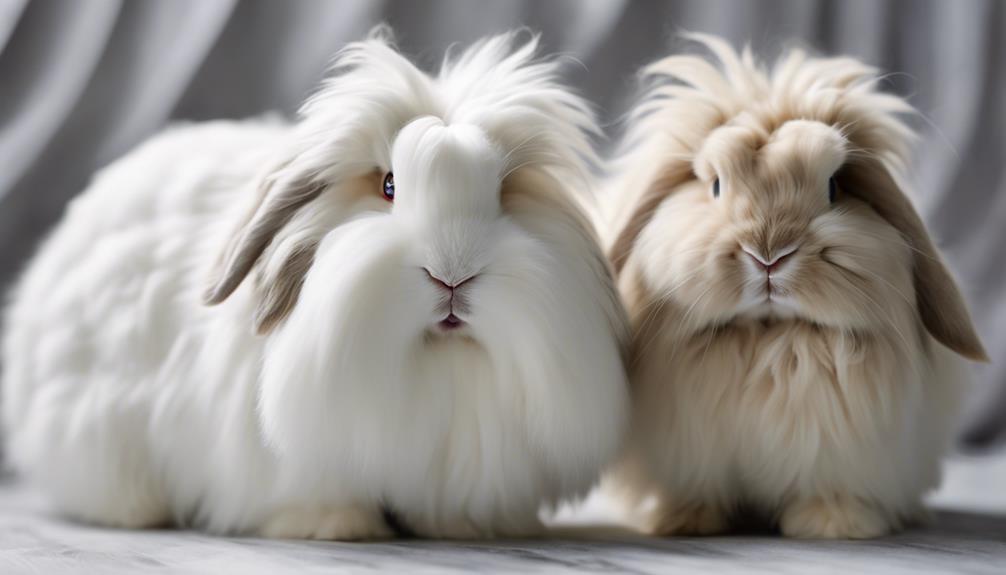
When comparing Angora rabbits, notable differences in size and weight become apparent, particularly between the two distinct breeds.
- French Angora rabbits are larger in size compared to English Angora rabbits.
- Female French Angora rabbits weigh up to 10 1/2 pounds, while female English Angora rabbits weigh up to 7 1/2 pounds.
- Females are generally larger than males in both the French and English Angora breeds.
The size and weight variations between French and English Angora rabbits are significant factors to consider when selecting a breed. Female French Angoras tend to be heavier than female English Angoras, with the French Angoras being the larger breed overall. These differences can impact housing requirements, dietary needs, and general care for the rabbits.
Understanding these distinctions is crucial for potential rabbit owners to ensure they can provide the appropriate environment and support for their chosen breed.
Health Considerations
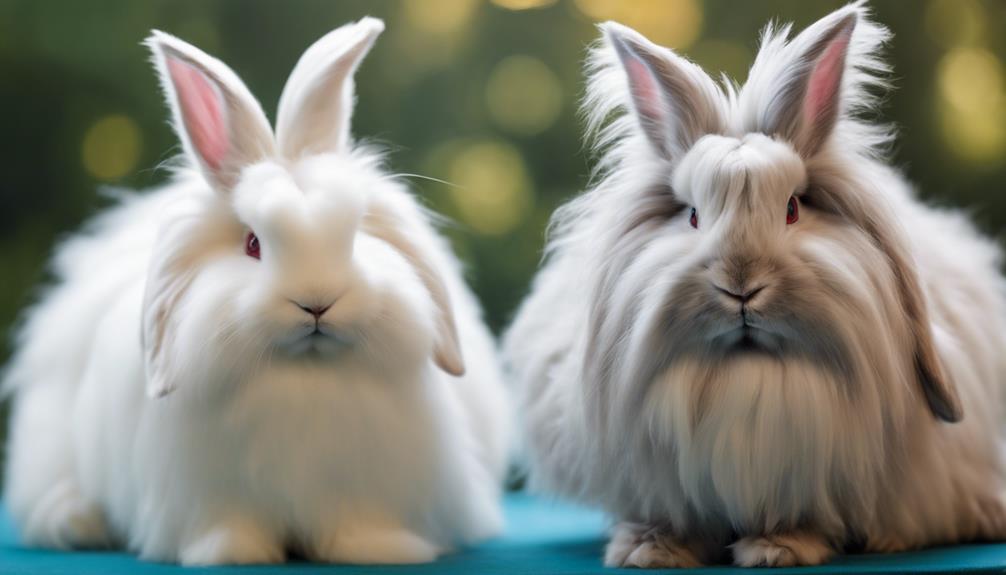
English Angora rabbits are more susceptible to wool block due to their long, fine wool, while French Angoras may face skin issues because of their dense undercoat. Regular grooming is essential for both breeds to prevent matting and maintain optimal health.
Additionally, English Angoras tend to be more sensitive to temperature fluctuations, whereas French Angoras require more space and exercise due to their higher energy levels.
Health Differences
French Angora rabbits present a higher susceptibility to wool block compared to their English counterparts due to their longer guard hairs. This can lead to potential health issues if not managed properly. When considering the health differences between English and French Angoras, some key points to note include:
- French Angoras may require specialized diets to support their higher fiber production.
- English Angoras may need more frequent grooming to prevent matting and tangling.
- Regular health check-ups are essential for both breeds to monitor and prevent wool block risks.
Understanding these distinctions can help rabbit owners provide the necessary care and attention to ensure the well-being of their furry companions.
Care Needs
Regular health checks play a crucial role in maintaining the well-being of both English and French Angora rabbits, ensuring early detection and prevention of potential health issues. When it comes to grooming, English Angoras have more sensitive skin, requiring gentle handling. French Angoras are hardier and less prone to skin irritations. English Angoras may need more frequent vet visits due to their delicate nature. English Angoras may require a specialized diet with higher fiber content to prevent digestive issues, while French Angoras can tolerate a more standard rabbit diet. Both breeds benefit from regular exercise, but English Angoras may need supervised playtime to prevent injuries due to their delicate build.
| Care Needs | English Angora | French Angora |
|---|---|---|
| Sensitivity | More sensitive skin, gentle grooming required | Hardier, less prone to skin irritations |
| Diet | Higher fiber content diet to prevent digestive issues | Can tolerate a standard rabbit diet |
| Vet Visits | May need more frequent vet visits due to delicate nature | Generally require fewer vet visits |
Care and Maintenance Tips

When caring for Angora rabbits, meticulous grooming and regular maintenance are essential to prevent matting and ensure overall well-being. Both English and French Angora rabbits require specific care to keep their fur in top condition. Here are some care and maintenance tips for these unique breeds:
- Regular Brushing: English Angoras, with their thick, long fur, need daily brushing to prevent mats and tangles. French Angoras, with their smoother fur, can benefit from brushing a few times a week to maintain their silky coat.
- Facial and Leg Hygiene: Both breeds need special attention to keep their faces, ears, and front legs clean. Regular cleaning in these areas helps prevent matting and maintains hygiene.
- Wool Quality Maintenance: English Angoras produce the softest wool suitable for spinning into yarn, while French Angoras have longer guard hairs. Proper grooming not only ensures the rabbits' well-being but also helps maintain the quality of their fiber.
Frequently Asked Questions
What Is the Difference Between French and English Angora Rabbits?
In French and English Angora rabbits, differences lie in grooming needs, shedding, size, temperament, coat texture, and dietary requirements. While French Angoras have shorter face hair, English Angoras display consistent wool across their bodies.
Which Angora Rabbit Should I Get?
When choosing between English and French Angora rabbits, consider grooming time, wool type, and desired size. English Angoras need more grooming due to dense wool, while French Angoras have cleaner faces. Decide based on lifestyle and preferences.
What Are the Four Breeds of Angora Rabbits?
In the world of Angora rabbits, the English, French, German, and Satin breeds stand out. Each breed offers unique qualities in terms of wool texture, appearance, size, and fiber production. Choosing the right one depends on personal preferences and specific needs.
How Do I Know if My Rabbit Is Angora?
To know if a rabbit is an Angora, look for distinctive facial furnishings and a thick coat that needs regular grooming. English Angoras have heavy wool on their face and ears, while French Angoras have shorter hair in those areas.









